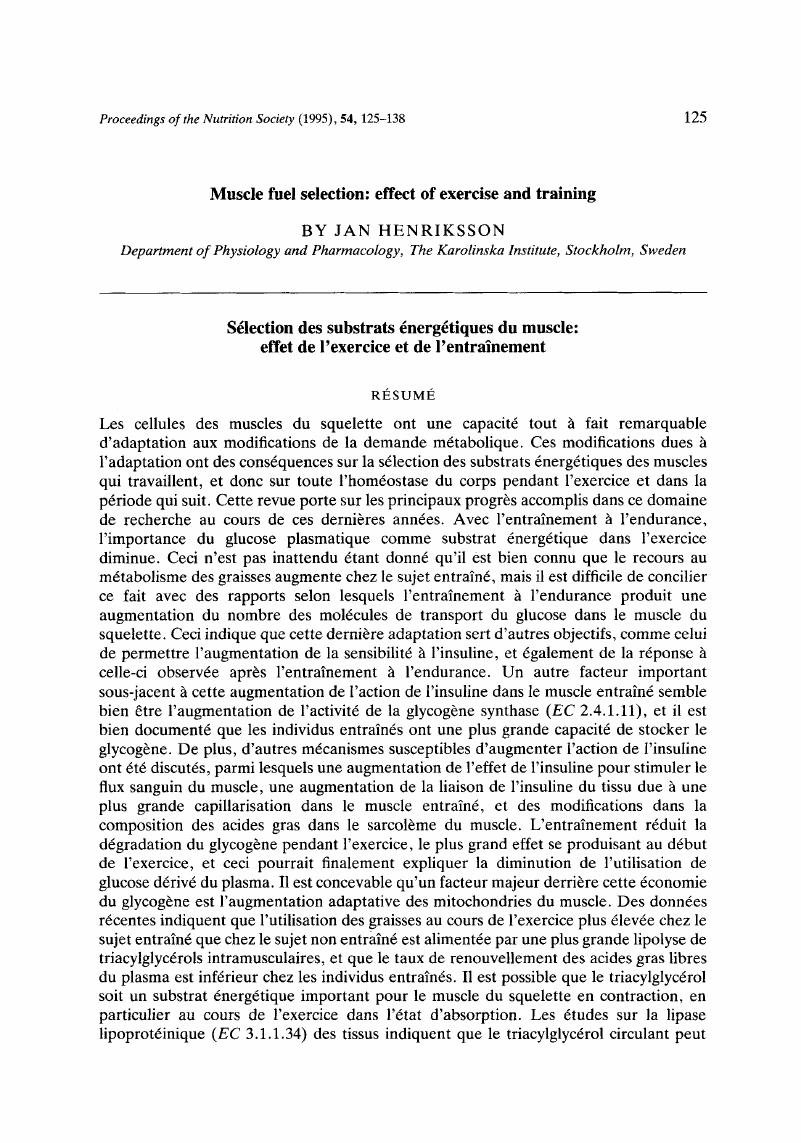Crossref Citations
This article has been cited by the following publications. This list is generated based on data provided by Crossref.
Hultman, Eric
1995.
Fuel selection, muscle fibre.
Proceedings of the Nutrition Society,
Vol. 54,
Issue. 1,
p.
107.
Symonds, Michael E.
and
Clarke, Lynne
1996.
Nutrition-Environment Interactions in Pregnancy.
Nutrition Research Reviews,
Vol. 9,
Issue. 1,
p.
135.
Hocquette, J.F
Ortigues-Marty, I
Pethick, D
Herpin, P
and
Fernandez, X
1998.
Nutritional and hormonal regulation of energy metabolism in skeletal muscles of meat-producing animals.
Livestock Production Science,
Vol. 56,
Issue. 2,
p.
115.
Obeid, Omar A.
Alhamdan, Adel A.‐W.
and
Emery, Peter W.
1998.
Glycogen synthesis in tumor‐bearing rats after ingestion of a high‐glycerol meal.
Nutrition and Cancer,
Vol. 30,
Issue. 1,
p.
59.
Levadoux, E
Morio, B
Montaurier, C
Puissant, V
Boirie, Y
Fellmann, N
Picard, B
Rousset, P
Beaufrere, B
and
Ritz, P
2001.
Reduced whole-body fat oxidation in women and in the elderly.
International Journal of Obesity,
Vol. 25,
Issue. 1,
p.
39.
Matzinger, Oscar
Schneiter, Philippe
and
Tappy, Luc
2002.
Effects of fatty acids on exercise plus insulin-induced glucose utilization in trained and sedentary subjects.
American Journal of Physiology-Endocrinology and Metabolism,
Vol. 282,
Issue. 1,
p.
E125.
Henriksson, Jan
and
Sahlin, Kent
2003.
Textbook of Sports Medicine.
p.
30.
Smekal, Gerhard
von Duvillard, Serge P
Pokan, Rochus
Tschan, Harald
Baron, Ramon
Hofmann, Peter
Wonisch, Manfred
and
Bachl, Norbert
2003.
Effect of endurance training on muscle fat metabolism during prolonged exercise:.
Nutrition,
Vol. 19,
Issue. 10,
p.
891.
LeBlanc, Paul J.
Peters, Sandra J.
Tunstall, Rebecca J.
Cameron‐Smith, David
and
Heigenhauser, George J. F.
2004.
Effects of aerobic training on pyruvate dehydrogenase and pyruvate dehydrogenase kinase in human skeletal muscle.
The Journal of Physiology,
Vol. 557,
Issue. 2,
p.
559.
van Baak, Marleen A.
and
Saris, Wim H.M.
2005.
Clinical Obesity in Adults and Children.
p.
363.
Frayn, Keith N.
and
Blaak, Ellen E.
2005.
Clinical Obesity in Adults and Children.
p.
102.
Smith, Aaron G.
and
Muscat, George E. O.
2006.
Orphan nuclear receptors: therapeutic opportunities in skeletal muscle.
American Journal of Physiology-Cell Physiology,
Vol. 291,
Issue. 2,
p.
C203.
Wagenmakers, Anton J.M.
Frayn, Keith N.
Arner, Peter
and
Yki-Järvinen, Hannele
2006.
Fatty acid metabolism in adipose tissue, muscle and liver in health and disease.
Essays in Biochemistry,
Vol. 42,
Issue. ,
p.
89.
Yamashita, Alex Shimura
Lira, Fábio Santos
Lima, Waldecir Paula
Carnevali Jr., Luiz Carlos
Gonçalves, Daniela Caetano
Tavares, Fábio Luis
and
Seelaender, Marília Cerqueira Leite
2008.
Influência do treinamento físico aeróbio no transporte mitocondrial de ácidos graxos de cadeia longa no músculo esquelético: papel do complexo carnitina palmitoil transferase.
Revista Brasileira de Medicina do Esporte,
Vol. 14,
Issue. 2,
p.
150.
Osler, Megan E.
and
Zierath, Juleen R.
2008.
Minireview: Adenosine 5′-Monophosphate-Activated Protein Kinase Regulation of Fatty Acid Oxidation in Skeletal Muscle.
Endocrinology,
Vol. 149,
Issue. 3,
p.
935.
Dillon, E. Lichar
Janghorbani, Morteza
Angel, James A.
Casperson, Shanon L.
Grady, James J.
Urban, Randall J.
Volpi, Elena
and
Sheffield-Moore, Melinda
2009.
Novel Noninvasive Breath Test Method for Screening Individuals at Risk for Diabetes.
Diabetes Care,
Vol. 32,
Issue. 3,
p.
430.
Coppack, Simon W.
2009.
Clinical Obesity in Adults and Children.
p.
115.
Frayn, K. N.
2010.
Fat as a fuel: emerging understanding of the adipose tissue–skeletal muscle axis.
Acta Physiologica,
Vol. 199,
Issue. 4,
p.
509.
SUZUKI, YOSHIO
SHIMIZU, TOMOMI
OTA, MAKOTO
HIRATA, RYUZO
SATO, KENJI
TAMURA, YOSHIFUMI
IMANISHI, AKIO
WATANABE, MASAYUKI
and
SAKURABA, KEISHOKU
2015.
Different training status may alter the continuous blood glucose kinetics in self-paced endurance running.
Experimental and Therapeutic Medicine,
Vol. 10,
Issue. 3,
p.
978.
Kaminski, Henry J.
Himuro, Keiichi
Alshaikh, Jumana
Gong, Bendi
Cheng, Georgiana
and
Kusner, Linda L.
2016.
Differential RNA Expression Profile of Skeletal Muscle Induced by Experimental Autoimmune Myasthenia Gravis in Rats.
Frontiers in Physiology,
Vol. 7,
Issue. ,



